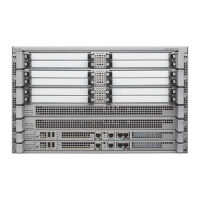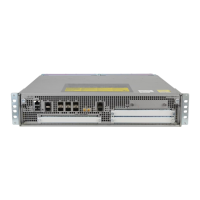• ATM SPA QoS—QoS on the ATM SPA is implemented in the segmentation and reassembly (SAR)
function using the ATM traffic classes (CBR, VBR-nrt, VBR-rt, and UBR) configured with PCR and
SCR values.
• Modular QoS CLI (MQC)—Supports per-VC policy maps with class-based weighted fair queueing
(CBWFQ), weighted random early detection (WRED), priority, shaping, bandwidth remaining ratio,
bandwidth remaining percent, and policing.
Configuring PPPoEoA on ATM SPAs
Beginning in Cisco IOS XE Release 2.5, you can configure PPP over Ethernet (PPPoE) on ATM (PPPoEoA)
to connect a network of hosts over a simple bridging-access device to a remote access concentrator. For more
information about this feature, refer to the “PPPoE on ATM” feature from the New Features in Cisco IOS XE
Release 2.5 at:
http://www.cisco.com/en/US/products/ps9587/products_feature_guides_list.html
For a sample configuration, see the PPPoEoA VC Class and PVC Range Configuration Example, on page
89.
Saving the Configuration
To save your running configuration to nonvolatile random-access memory (NVRAM), use the following
command in privileged EXEC configuration mode:
To permanently save your configuration changes, you must write them to the nonvolatile RAM (NVRAM)
by entering the copy running-config startup-config command in privileged EXEC mode.
Note
PurposeCommand
Writes the new configuration to NVRAM.Router# copy running-config startup-config
For more information about managing configuration files, refer to the Cisco IOS XE Configuration
Fundamentals Configuration Guide, Release 2, and Cisco IOS Configuration Fundamentals Command
Reference publications for your specific software.
Shutting Down and Restarting an Interface on a SPA
Shutting down an interface puts it into the administratively down mode and takes it offline, stopping all traffic
that is passing through the interface. Shutting down an interface, though, does not change the interface
configuration.
As a general rule, you do not need to shut down an interface if you are removing it and replacing it with the
same exact model of SPA in an online insertion and removal (OIR) operation. However, we recommend
shutting down an interface whenever you are performing one of the following tasks:
•
When you do not need to use the interface in the network.
Cisco ASR 1000 Series Aggregation Services Routers SIP and SPA Software Configuration Guide, Cisco IOS
XE Everest 16.5
84 OL-14127-17
Configuring the ATM SPAs
Configuring PPPoEoA on ATM SPAs

